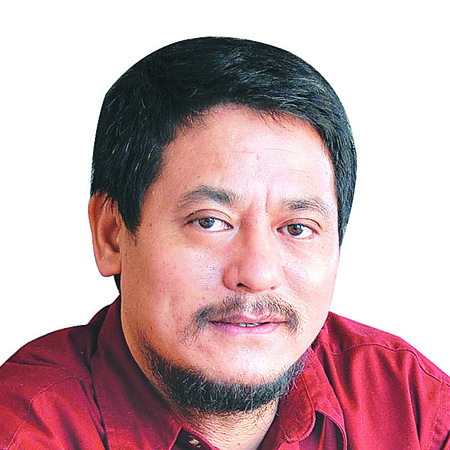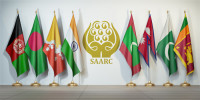Opinion
A formidable challenge
Without substantive changes, the District Autonomous Councils will likely trigger a chain of instability in India’s north-east
Mahendra P Lama
The eight Indian states of North East region (NER)—Arunachal Pradesh, Assam, Manipur, Meghalaya, Mizoram, Nagaland, Sikkim and Tripura—constitute 7.9 percent of India’s total geographical area, 3.76 percent of the total national population and hardly 2.8 percent of the net state domestic product. The Indian north-eastern frontier constitutes over 36 percent of the total land borders of 15,106km of India. This makes the NER an integrated geographical unit where over 98 percent of its border is with India’s international neighbours and less than two percent with the rest of India. The region is connected by the 27km long Siliguri Corridor—also known as “Chicken’s neck”—in Darjeeling district.
Overwhelmingly hilly and mountainous, landlocked and agricultural, the NER has an acute deficit of infrastructure including connectivity within the eight states as well as with the rest of India and neighbouring countries. All the states in the NER were put in the Special Category States (SCS) till the recommendations of the 14th Finance Commission in 2014 was implemented. Under the SCS the NER received liberal funding for both the central sector and externally aided projects.
Special treatment
The NER has been bestowed with special constitutional, institutional, development and financial provisions that give the states a significant degree of federal autonomy and devolution. There are very special provisions in the Constitution of India for the NER in subjects related to the Panchayats (Part IX); scheduled and tribal areas (Part X); temporary, transitional and special provisions (Part XXI) for Nagaland (Article 371A), Assam (Article 371B), Manipur (Article 371C), Sikkim (Article 371F), Mizoram (Article 371G) and Arunachal Pradesh (Article 371H) and Sixth Scheduled Areas (Articles 244(2) and 275(1)).
The other major innovative fund for these states is provided under ‘New Initiatives for the North Eastern Region’ of 1996 wherein at least 10 percent of the Plan Budget(s) of the Central Ministries/Departments is allocated for the development of the NER. This is a huge resource transfer for hardly four percent of India’s population. In order to isolate from the regular budgetary lapse towards the end of each fiscal year, the unspent balance accrues to the Non-Lapsable Central Pool of Resources (NLCPR), created in 1997-98, which could get accumulated year after year and be drawn whenever required mainly for infrastructure development. For instance, a recent report mentioned that during 2014-15 alone about Rs48,000 crore was available to the NER as central sector fund.
The government of India set up the North Eastern Council in 1971 and also initiated the Ministry of Development of North Eastern Region (MDoNER) in 2004. This is the only ministry with an exclusive territorial jurisdiction in India. It coordinates the planning, execution and monitoring of the developmental schemes and projects. Many specialised agencies have been set up in the last two decades exclusively for the NER.
Regional autonomy
However, the NER and the nearby regions are one of the most noted theatres of conflict. The entire eastern frontier had been a zone of conflict, war, and instability. These conflicts in the form of insurgency, secessionist acts and identity-autonomy assertion, uprising and liberation war and border disputes have been both intra- and inter-state. These conflicts are mostly triggered by the bourgeoning gap between the identity-development aspirations of the people and the governments’ ability to fulfil them.
The central government has adopted a range of approaches to resolve these conflicts including signing peace accords, according full-fledged statehood and pouring huge development packages. A key intervention has been the Sixth Schedule of the Indian Constitution. Under these, the District Autonomous Councils (DACs) have been in vogue since the 1950s wherein many of the districts have been provided with functional and development autonomy including legislative, executive and judicial power. Some of these councils were also graduated into full-fledged constituent states like that in Meghalaya, Manipur and Mizoram. These councils are not even covered by Part 9A and 9B of the constitution, which deal with the implementation of the Panchayati Raj.
Even in the last decade, whenever there were ethnic and local conflicts in the region—like the Bodos in Assam, the Hmars and Kukis in Manipur and Gorkhas in West Bengal—the trend has been to offer the rebel parties a readymade solution of regional autonomy within the existing state apparatus. This is done through two distinct approaches. First, it is carried out under the Sixth Schedule which provides constitutional sanction and validity for new autonomous councils to be established (Karbi Anglong Autonomous Council and Bodo Territorial Councils in Assam; Chakma and Hajong Autonomous Councils in Mizoram).
Second, it is also created by simple gazette notification of the affected state government as is the case with the Darjeeling Gorkha Hill Council (DGHC) in 1988 and Gorkhaland Territorial Administration (GTA) in 2012 in West Bengal. However, this model has no constitutional validity. These regional/district autonomy models as practiced in the Indian North East regions is now being studied by other neighbouring countries including Bangladesh, Sri Lanka and Myanmar.
Behind the picture
Despite these generous provisions, there is a serious gap in the development thinking at the national and local levels, restricted devolution in both administrative and financial powers, hurdles in autonomy in legislative functions and serious impediments in larger political participation. Besides, there are apparent clashes of interest first between the central and the state governments and between the latter and these DACs.
There are constant threats from the state government on the possible dissolution of the elected councils. Councils complain that the state governments have been very slow in handing over the agreed departments and budgetary allocations. There have been confusions and conflicts. In Darjeeling, the famous Victoria and Eden-Sadar hospital was under DGHC but the Chief Medical Officer was appointed by the Bengal Government, and Tourism Department remained with DGHC and its Corporation with Bengal government. Many of the Councils have very poor infrastructures, no planning bodies and are cradles of corruption. Most of the councils still run in a strict institutional framework and functional parameters of pre-reforms period. A review of the functioning of the autonomous councils by National Expert Committee on Planning for the Sixth Schedule Areas appointed by the central government in 2006 clearly reveals appalling gaps and laggardness in their functioning. If substantive changes in the legal framework, resource sharing, governance and devolution structures are not injected, there are strong possibilities that these councils themselves will trigger a chain of instability in the region.
The DACs today ought to reposition themselves as resilient and dynamic mode of conflict resolution. For this to happen, institutional framework, development devolution and, more critically, functional autonomy need to be reassessed. The perception about the borders and border regimes need to be made liberal and widened. This will help recognise the criticality of the DACs interaction with cross border economic institutions and social networks. Since most of these regional councils are located in the border areas, they could be allowed to make a substantive cross-border interaction in areas like tourism, education, health, energy, bio-diversity, trade and investment. This would also mean a major shift in national security perception. This is a formidable challenge.
Lama, former member of National Security Advisory Board, Government of India, is a professor of South Asian Economies at Jawaharlal Nehru University, New Delhi and a member of the Eminent Persons Group (EPG) from India. He can be reached at [email protected]




 15.12°C Kathmandu
15.12°C Kathmandu










